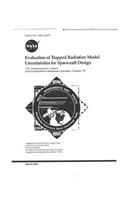
Evaluation of Trapped Radiation Model Uncertainties for Spacecraft Design
Series:
The standard AP8 and AE8 models for predicting trapped proton and electron environments have been compared with several sets of flight data to evaluate model uncertainties. Model comparisons are made with flux, dose, and activation measurements made on various U.S. low-Earth orbit satellites (APEX, CRRES, DMSP, LDEF, NOAA) and Space Shuttle flights, on Russian satellites (Photon-8, Cosmos-1887, Co
NaN
VOLUME
English
Paperback

The standard AP8 and AE8 models for predicting trapped proton and electron environments have been compared with several sets of flight data to evaluate model uncertainties. Model comparisons are made with flux, dose, and activation measurements made on various U.S. low-Earth orbit satellites (APEX, CRRES, DMSP, LDEF, NOAA) and Space Shuttle flights, on Russian satellites (Photon-8, Cosmos-1887, Cosmos-2044), and on the Russian Mir Space Station. This report gives a summary of the model-data comparisons-detailed results are given in a companion report. Results from the model comparisons with flic, ht data show, for example, the AP8 model underpredicts the trapped proton flux at low altitudes by a factor of about two (independent of proton energy and solar cycle conditions), and that the AE8 model overpredicts the flux in the outer electron belt by an order of magnitude or more.Armstrong, T. W. and Colborn, B. L.Marshall Space Flight CenterRADIATION TRAPPING; PROTONS; LONG DURATION EXPOSURE FACILITY; MATHEMATICAL MODELS; SOLAR CYCLES; LOW ALTITUDE; LOW EARTH ORBITS; DMSP SATELLITES; CRRES (SATELLITE); MIR SPACE STATION; SPACE TRANSPORTATION SYSTEM FLIGHTS; SPACE SHUTTLE
Price Comparison [India]
In This Series
Bestseller Manga
Trending NEWS




















